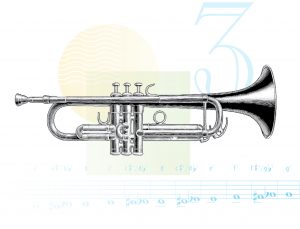 Madeline, our Account Services Director and writer, has a funny story about trumpets:
Madeline, our Account Services Director and writer, has a funny story about trumpets:
I played the oboe in middle and high school (the one that looks like a mini-clarinet with the tiny double-reed). Then, the summer before my senior year, my family moved. My new school had a marching band, which my old school didn’t offer. When I met the band director, he asked if I was interested in marching, and, as any proper band geek would, I excitedly said yes.
The challenge was twofold: 1) oboes typically don’t march. The fragility of the reed and the precision required for tuning on the double-reed make walking around while playing pretty tenuous.
2) The marching band already had the songs and choreography set for the fall football season, and there wasn’t a space in the flute or clarinet line, where I could have easily played a 3rd chair part without much difficulty. The only space in the choreography was in the trumpet line, left by a freshman who decided he wanted to play football instead of the halftime show.
I told the band director (dear, beloved Mr. Gerhardt) that clearly playing the trumpet couldn’t be THAT HARD, what with it only having three keys. My oboe had something like 22.
He appeared impressed at my ignorance, or maybe impressed by my naive confidence. Regardless, he loaned me a trumpet and gave me a fingering chart and the third chair part for the Star Spangled Banner (which I scoffed at — I would have to learn 4 notes). I said I’d see him at marching practice bright and early the next morning. He raised his eyebrows at me, gave me a one-sided smile, and bid me good luck.
That evening at home, I was quickly humbled. The mouth piece was impossible. My lips were supposed to do all the vibrating, which I found unbearably strange-feeling. Then, with only 3 valves, I had no idea what note I was playing, because the shape of the fingering was only half of the equation. The other half was me: I needed to know what the note was supposed to sound like, and then adjust my embouchure (mouth positioning) and air flow to “find” that note.
Brass players were magician musicians, and I never knew.
Madeline’s experience with the trumpet is one we often see in other creative venues, where the artist makes their art LOOK EASY. If you watch a photographer work, what you see is him looking through the viewfinder and pushing the shutter to capture an image.
Easy, right?
The three valves on the trumpet make it look easy to play. But the opposite is true. The majority of the work for tuning and playing correct notes comes from the musician’s deep knowledge of pitch-making. The camera with its shutter and viewfinder make it seem like it would be easy to take a photograph. Without deep knowledge of all the invisible decisions a photographer must make, taking a good photograph can be impossible.
What happened with Madeline and her marching band career?
The next day, I went back to Mr. Gerhardt and told him I’d need some help. Ever kind and generous, he sat with me to help me learn the 4 notes for the Star Spangled Banner. We then went out onto the football field, and I realized that not only did I have to learn and play these four notes on what seemed an impossible instrument, I also had to learn how to march, and to memorize the choreography, and memorize the songs…
I managed. I don’t think I screwed things up too badly, and for most of the season I prioritized learning choreography so that I wouldn’t be VISIBLY out of place. If I wasn’t sure of what I was supposed to be playing, I just held the trumpet and didn’t play.
Trumpet players are magic.
Madeline left the heavy lifting to the trumpet players in her line who knew what they were doing. They had deep knowledge of their instrument, which she did not, and she knew that she was better off leaving the job to them.
At Hayman Studio, our creative team has deep knowledge of our tools. We make it look easy, so it IS EASY… for you. We’d love to be that expert extension of your team.
Leave a reply